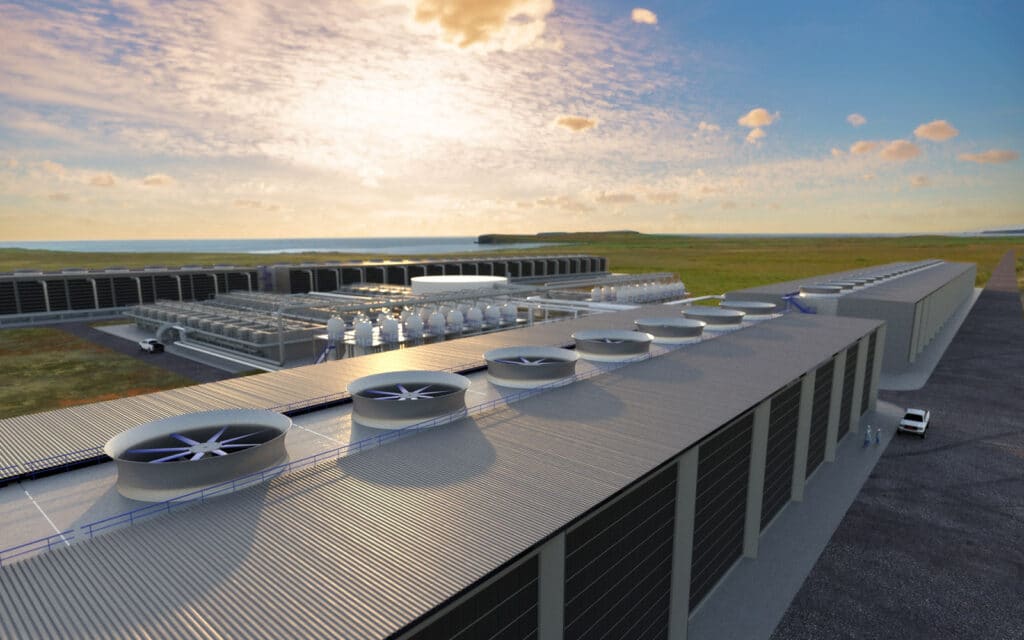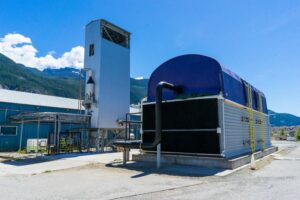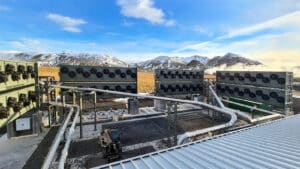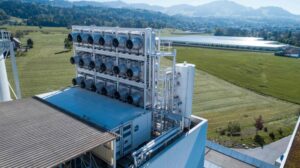
Capturing Carbon from the Air: The Futuristic Technology that Might Solve the Climate Crisis
By Ginny Dorn
According to the International Energy Agency (IEA), the world currently has 19 direct air capture (DAC) plants in operation. In total, these plants are capturing 0.1 Mt of CO2 per year. While carbon capture and sequestration is an exciting technology, it’s only barely being funded and developed now, at a critical time in our journey with climate change. Yet DAC is a potentially viable solution to our climate problem, offering the promise of removing CO2 from our atmosphere to either use in the manufacturing of products or to store underground. If all goes right, we could potentially use DAC technology to reverse climate change and remove the legacy carbon that we’ve been pumping into the atmosphere for the last 150 years. Time is ticking – here’s what you need to know about the benefits and drawbacks of Capturing Carbon from the Air.
What Is Direct Air Capture?
In the late 1990s, scientists first brought about the idea of direct carbon removal. Noticing the upward trend in fossil fuel emissions, combined with rapidly developing countries, scientists knew that we would soon experience a boom in emissions. With wind and solar power too expensive to compete with fossil fuels and the general public ignoring warnings about the need to slow our use of fossil fuels, the scientists began looking for other solutions. Klaus Lackner, Peter Eisenberger, and David Kieth connected and shared similar ideas, and direct air capture was born. All three of the scientists eventually went on to begin working on creating direct air capture companies.
DAC technology is able to extract CO2 from the atmosphere directly, which we can then use to make new products or store deep underground, in geological formations, permanently. With the latter, we would effectively achieve negative emissions and reverse climate change by completely removing carbon from the atmosphere. There are two different approaches to DAC technology, each working in its own way. Liquid DAC systems push captured air through chemical solutions, such as a hydroxide solution, which then removes the CO2. While the CO2-removed air is returned to the environment, the chemical solution is reintegrated back into the process via high-temperature heat. Alternatively, solid DAC pushes captured air through solid sorbent filters, which chemically bind with carbon. The filters are then placed under a vacuum and heated, which releases the CO2 concentrate from the filters and captures it for use or storage.
In either case, companies creating DAC technology chose to go with one of two methods – either create really big Capturing Carbon from the Air facilities that we would need in minimal quantities, or create smaller DAC technology that we would use in mass quantities. As the three founding scientists began to create their own DAC technology, they made use of existing technology. Submarines and spacecraft were already capturing carbon, as it is necessary to ensure that air aboard these vessels is breathable. Fossil fuel companies had created scrubbing systems that would capture carbon from smokestacks, and sorbent chemicals that could sequester carbon already existed. Over the years, it has taken a million small tweaks to improve the technology bit by bit, the issue being how incredibly dilute CO2 is in the air – to effectively capture carbon, we need to bring huge volumes of air through the machines. Eventually, the three scientists and newer additions to the industry created more and more efficient DAC technology – bringing us to the 19 plants we have in operation today.
Why Choose Carbon Capture?
We’ve known about the issues with carbon emissions for decades. As a result, scientists have covered a laundry list of possible solutions, none of which we have been able to scale to the level that would be required for real change. Convenience, financial support, land, and politics tend to be the detractors in every scenario. Reducing our emissions should always be the number one priority, but is also the hardest to do – people and businesses are set in their ways, and developing nations want the same access to cheap energy as developed nations had when they were developing.
Many options look at ways to increase carbon drawdown. For example, experts have looked at using nature-based solutions, like aforestation and reforestation – planting new trees where no trees have been before and repopulating deforested areas – as a means of ramping up carbon sequestration. However, to effectively plant enough trees to meet our goal of net zero emissions by 2050, we’d need to use 80% of all the existing farmland globally. We’ve also explored BECCS – Bioenergy With Carbon Capture and Sequestration (or Storge) – wherein we would burn the biomass of fast-growing crops to generate electricity, then capture the CO2 that would result from this and inject it into the earth. While the idea seemed great on paper, in actuality it would require too much land – we’d need to use about 40% of the cropland on the planet just to grow the crops that the BECCS plants would burn.
Renewable and clean energies
Then there are the countless renewable and clean energies that we could have invested in earlier on to avoid some of our CO2 emissions. Things like solar power, wind energy, and natural gas were viable options, but have ultimately not been applied in large enough quantities early enough to avoid the critical position we find ourselves in. Between lobbying for funding and fighting against big fossil fuel companies, these potential emission savers never got a real chance.
Similarly, DAC has been discussed at length since its conception, and especially now as it gains steam and begins to show its true potential. A 2018 report from the U.N.’s Intergovernmental Panel on Climate Change (IPCC) found that if we want to limit global warming to 1.5 degrees Celcius – the tipping point for potentially catastrophic changes to daily life – we need to cut our atmospheric CO2 quickly and drastically. The other options – focusing on renewables and planting trees – are still critical, but we will likely need to pull carbon out of the atmosphere, too, to reach our goal. This report encouraged investors and policymakers to take DAC seriously. DAC became not just an option, but necessary on a massive scale for survival. Now, we had buy-in and just needed enough investments to scale DAC companies to the size they need to be to effectively use carbon capture against climate change. This year, the IPCC reported that our situation could begin declining so quickly that we have no choice other than to begin removing carbon from the atmosphere – regardless of price. We will likely need to use as many solutions as possible to limit the effects of climate change, quickly.
What Do We Do With the Carbon After Capture?
There are two main things we do with captured carbon – we either use it to create a new product or store it underground. We can use it to carbonate soda or add it to concrete. We can also use it to create consumer goods, like plastic, diamonds, clothes, alcohol, and more. Unfortunately, making products like this is still very new and very limited.
Large-scale uses for captured CO2 would likely cause a rerelease of CO2 back in the air. The most popular and likely option is synthetic fuels, which can be made in a variety of ways and can act as a substitute for any liquid fuel. That means that these synthetic fuels, or synfuels, could power our cars, SUVs, airplanes, and even power plants. While burning this new fuel would release more CO2, a future full of caron capture facilities could just recapture the CO2 – an ongoing catch-and-release, closed-loop solution. Capturing Carbon from the Air experts propose that we use solar and wind power to turn the CO2 into fuel, making it a greener option. Since the biggest issue with solar and wind power is the struggle to store these energies, we can essentially solve the storage distribution problem we have with these renewables while also finding a use for carbon. Still, we don’t have enough solar and wind power to scale this solution to net neutral emissions – we’d need massive expansion for this to be a viable solution.
Store and deliver of synfuels
We’d also need a way to store and deliver synfuels. One option would be to partner with oil companies, using their existing infrastructure as part of the solution. This could potentially take much of the pressure for investments off. Since funding is one of the biggest issues with scaling DAC, creating synfuels and partnering with oil companies could quickly improve DAC technology and make it cheaper each year – possibly helping to bring the cost down to $50 per ton within decades. This solution could, theoretically, help us reach net neutral emissions with transportation, but we won’t be able to begin drawing down carbon from the atmosphere until about 2060.
Synfuel as a solution for excess CO2
As promising as it sounds, there are some big issues with using synfuel as a solution for excess CO2. June Sekura, who analyzed 200 academic papers on DAC, identified the risks. She says that leaks in CO2 pipelines could be deadly. Since CO2 is heavier than oxygen and nitrogen, a leak would cause concentrated CO2 to hover near the ground, sickening and killing people, pets, and livestock. Based on our history, pipelines would likely be routed through our poorest areas. Industrial facilities also tend to be concentrated in communities of color – adding DAC facilities to these industrial areas would also mean that we disproportionately put people of color at risk.
Reverse climate change through Capturing Carbon from the Air
We will also need to bury captured carbon in the earth, which could essentially reverse climate change. To accomplish this, we’d need to remove all of the carbon we’ve emitted into the atmosphere over the last 150 years. Again, Sekura notes that there are potential issues with this idea. We’d need to transport CO2 from DAC facilities to areas with the right subterranean rock that can sequester the gas, which would call for a network of specialized high-pressure pipelines across the entire country. We would need 12 times the amount of pipelines that we have today – at least 65,000 miles worth – and Sekura says the pipelines we have today aren’t appropriate for this purpose. Whatever we may choose to do with the carbon, we’d need to act now and acquire much more funding for it to happen. To reach the IPCC’s 10 billion tons of carbon drawdown by 2050, we’d need 30,000 large-scale plants, of which we only have one today.
Do We Actually Have Funding for Direct Air Capture?
Carbon capture companies like Carbon Engineering or Climeworks charge about $500 per ton of CO2 captured. To meet the IPCC’s goal of sequestering 10 gigatons each year by midcentury, we’d spend $5 trillion each year – much more money than anyone in DAC has. Experts believe that DAC will only be a viable option when companies get the price down to $100, at most, per ton of captured CO2. This is, in part, why creating synfuels and partnering with oil companies could be the most logical option. While not perfect, it could solve our funding issue.
Funding for DAC
Funding for DAC has come from a variety of places. Private investors, like Bill Gates and Murray Edwards, helped kick off the first carbon capture company, Carbon Engineering, with $3.5 million in starter money. Small investments like these have helped get many DAC companies off the ground, but it’s still nearly not enough. Some public funding has come out of the U.S. government – a recent infrastructure bill passed the Senate which contains $11.5 billion for carbon capture efforts. This includes $2.5 billion to build four different direct air capture hubs that will, hopefully, create an entire network of green energy jobs. The Department of Energy is offering a $12 million grant to support the development of direct air capture technologies. DAC could also be included in the $3.5 trillion dollar budget blueprint submitted by the Democrats, in which $150 billion would go to compensating energy producers that make the switch to lower-emissions processes.
Government subsidies available
There are also government subsidies available via Section 45Q of the tax code. Any firm that can capture and sequester carbon by the ton qualifies, which has helped DAC companies to become somewhat profitable. For example, a large facility being built in Texas by Oxy Low Carbon Ventures could earn $35 from the 45Q credit and $200 from California’s offset option, which can apply to any state, for every ton captured. The facility could potentially remove one million metric tons of CO2 per year. That means the facility could theoretically earn as much as $235 million per year in subsidies alone – and the Biden administration is working on expanding the 45Q program. Washington and California also offer a tax credit for companies that sequester CO2.
Meanwhile, Elon Musk is offering a $100 million “XPrize” for people who can create and demonstrate a solution that can pull carbon dioxide directly from the oceans or atmosphere, and then sequester it sustainably. Any solution is eligible, including DAC. Even companies like Shopify and Stripe have millions budgeted to buy sequestered CO2, aiming to provide support and funding for DAC companies.
Big fossil fuel companies to join Capturing Carbon from the Air
Despite this financial support, many entrepreneurs say that we will only be successful if we get big fossil fuel companies to join in. These industries have the infrastructure and knowledge needed to scale DAC facilities to the size they need to be while also piping captured carbon to permanent sequestration locations. Even if we did get Big Oil on board, we might not be able to afford to capture legacy carbon – the carbon that has been in our atmosphere for the last 150 years – until the year 2060. Only then will DAC be cheap enough for people to be willing to pay. In the meantime, it’s likely that we will only use DAC for short-term improvements, like capturing CO2 to use as fuel before releasing it again.
Is DAC Worth It?
Like all other climate change solutions, there are tons of pros and cons to consider with DAC. Some environmentalists and experts say that DAC is too costly, both financially and energetically. Some believe that the energy spent on DAC would be better used to push for removing oil-burning engines and electrifying our economies. DAC is still being refined, and we already have the ability to apply electricity. Again, it comes down to money and politics. When we have the political will and investments needed, we can make anything happen.
Saving the planet
Despite the cost of DAC, we may be forced to spend the money to save the planet. The IPCC’s deadline of 2050 is fast approaching, and we are on track to surpass the 1.5-degree tipping point. If the effects of climate change worsen, as we can expect that they will, we might pay for DAC regardless of price, as we will have no other choice. This would, in effect, build out an air treatment infrastructure, just like the water treatment infrastructure that was built out as a result of cholera and typhoid outbreaks. As history shows us, when put into a dire situation, humans adapt. Will we use DAC to adapt to climate change? Time will tell.
Learning Hub @ GBRI provides you access to 100s of sustainability, green building and LEED courses.
To learn more about click here in link for our course on Capturing Carbon from the Air:
https://stag.gbrionline.org/courses/capturing-carbon-from-the-air/














